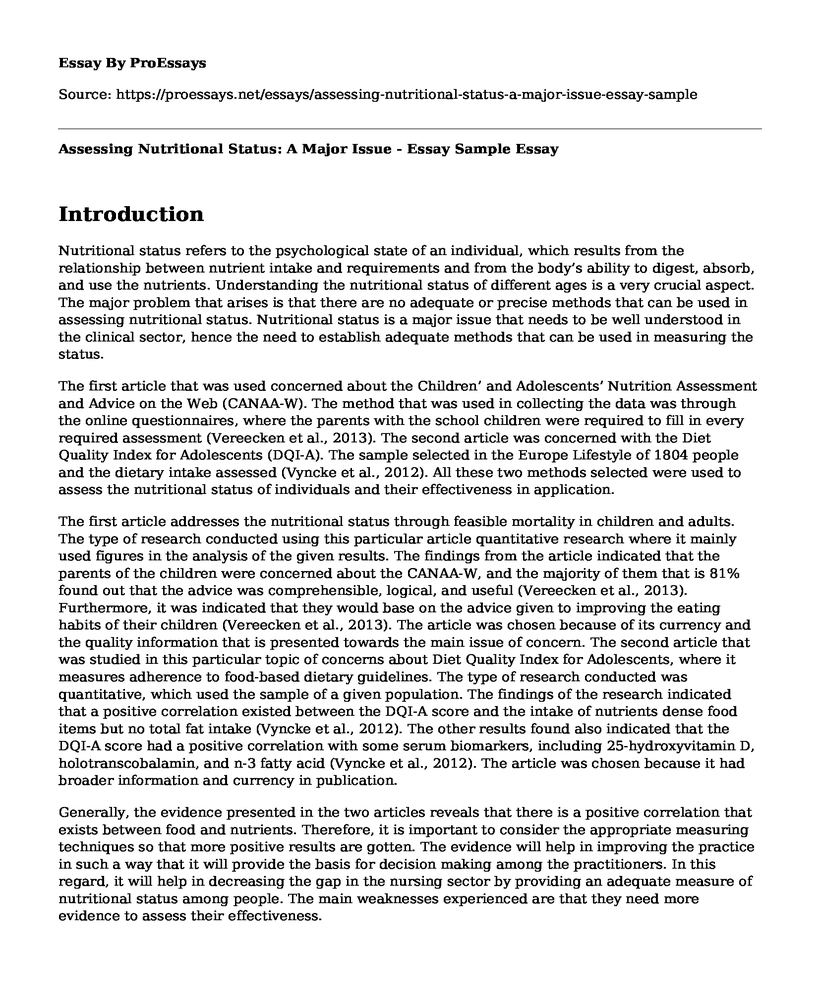Introduction
Nutritional status refers to the psychological state of an individual, which results from the relationship between nutrient intake and requirements and from the body’s ability to digest, absorb, and use the nutrients. Understanding the nutritional status of different ages is a very crucial aspect. The major problem that arises is that there are no adequate or precise methods that can be used in assessing nutritional status. Nutritional status is a major issue that needs to be well understood in the clinical sector, hence the need to establish adequate methods that can be used in measuring the status.
The first article that was used concerned about the Children’ and Adolescents’ Nutrition Assessment and Advice on the Web (CANAA-W). The method that was used in collecting the data was through the online questionnaires, where the parents with the school children were required to fill in every required assessment (Vereecken et al., 2013). The second article was concerned with the Diet Quality Index for Adolescents (DQI-A). The sample selected in the Europe Lifestyle of 1804 people and the dietary intake assessed (Vyncke et al., 2012). All these two methods selected were used to assess the nutritional status of individuals and their effectiveness in application.
The first article addresses the nutritional status through feasible mortality in children and adults. The type of research conducted using this particular article quantitative research where it mainly used figures in the analysis of the given results. The findings from the article indicated that the parents of the children were concerned about the CANAA-W, and the majority of them that is 81% found out that the advice was comprehensible, logical, and useful (Vereecken et al., 2013). Furthermore, it was indicated that they would base on the advice given to improving the eating habits of their children (Vereecken et al., 2013). The article was chosen because of its currency and the quality information that is presented towards the main issue of concern. The second article that was studied in this particular topic of concerns about Diet Quality Index for Adolescents, where it measures adherence to food-based dietary guidelines. The type of research conducted was quantitative, which used the sample of a given population. The findings of the research indicated that a positive correlation existed between the DQI-A score and the intake of nutrients dense food items but no total fat intake (Vyncke et al., 2012). The other results found also indicated that the DQI-A score had a positive correlation with some serum biomarkers, including 25-hydroxyvitamin D, holotranscobalamin, and n-3 fatty acid (Vyncke et al., 2012). The article was chosen because it had broader information and currency in publication.
Generally, the evidence presented in the two articles reveals that there is a positive correlation that exists between food and nutrients. Therefore, it is important to consider the appropriate measuring techniques so that more positive results are gotten. The evidence will help in improving the practice in such a way that it will provide the basis for decision making among the practitioners. In this regard, it will help in decreasing the gap in the nursing sector by providing an adequate measure of nutritional status among people. The main weaknesses experienced are that they need more evidence to assess their effectiveness.
I would share the information obtained from this study with parents who would not have come across it. This will help them to make various decisions and act as guidelines for taking care of their children. In sharing this information, I will offer the findings of what a certain process has assisted so as to build confidence. Resources such as clinical reports would help in sharing this kind of information. Sharing this evidence with the nursing profession will help in delivering quality services regarding nutrition to individuals.
Conclusion
In conclusion, nutrition status is a very important aspect to consider in the nursing sector. Therefore, measuring nutrition must be applied in every clinical sector. Majorly, CANAA-W, and DQI-A are the major methods that can be used in measuring the nutritional status among the individuals. It is then important to consider their evidence as it helps in decision making in the clinical sector.
References
Vereecken, C., Covents, M., Maes, L., & Moyson, T. (2013). Formative evaluation of the dietary assessment component of C hildren's and A dolescents' N utrition A ssessment and A dvice on the W eb (CANAAW). Journal of human nutrition and dietetics, 27, 54-65. https://pubag.nal.usda.gov/?page=12230&per_page=100&search_field=all_fields&sort=date-desc
Vyncke, K., Fernandez, E. C., Fajó-Pascual, M., Cuenca-García, M., De Keyzer, W., Gonzalez-Gross, M., ... & Albers, U. (2012). Validation of the Diet Quality Index for Adolescents by comparison with biomarkers, nutrient and food intakes: the HELENA study. British journal of nutrition, 109(11), 2067-2078. https://digital.csic.es/bitstream/10261/84540/1/Validation_of_the_Diet_Quality_validation_of_the_Diet_....pdf
Cite this page
Assessing Nutritional Status: A Major Issue - Essay Sample. (2023, Aug 28). Retrieved from https://proessays.net/essays/assessing-nutritional-status-a-major-issue-essay-sample
If you are the original author of this essay and no longer wish to have it published on the ProEssays website, please click below to request its removal:
- Nursing Curriculum for College Level Paper Example
- Molecular Modeling and Virtual Screening in Modern Drug Discovery Paper Example
- Firefighters: Mental & Physical Skills to Handle Disasters - Research Paper
- Eating Out During COVID-19: Is Takeout & Delivery Safe? - Essay Sample
- Nurses: An Integral Part of Healthcare Systems - Essay Sample
- Maximizing Reimbursement: Drintin Hospital's Financial Improvement Steps - Essay Sample
- Essay Example on Human Circadian Rhythms







